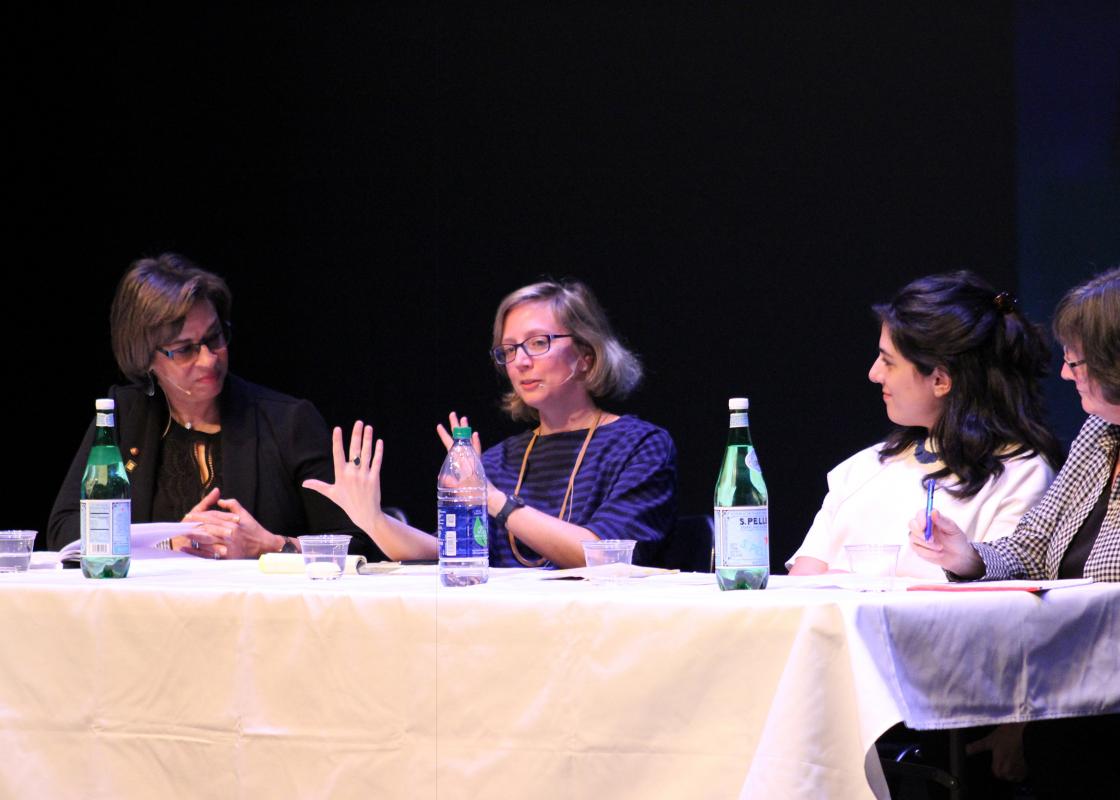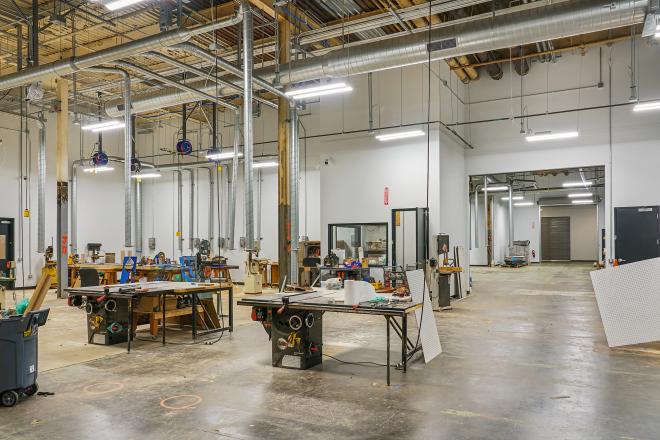Marie Rodriguez is an architectural designer and historian living in Houston. She holds an M.Arch from Rice University and an MS from McGill University with a specialization in domestic environments.
On the evening of March 27, on a Wednesday night in Midtown, a cacophony of female voices descended upon the unsuspecting patrons of Holman Draft Hall. Lively discussions filled the night air: Who is a design leader? Who is a creative manager? Should those two roles overlap? How do women negotiate their career choices and what do they sacrifice in order to succeed in architecture? These women, practitioners in architecture, engineering, and design, had just attended the Houston AIA Women in Architecture (WIA) panel discussion, “Me to We: An Authentic Look at Collaborators in the Practice of Architecture.” Five panelists, women from different backgrounds and experiences in the design industry, shared their insights on equity and collaboration in architecture. Primed to continue the discussion in a more casual setting, the attendees headed to the bar, abuzz with comments, honest discussion, and poignant questions on how the hot topic of collaboration can possibly be the key to creating greater equity for women in the design fields. A video recap of the event is available here.
The WIA committee strives to bring more awareness to the role women have in Houston architecture and their latest attempt with part one of the 2019 Equity series was met with enthusiasm by WIA members and nonmembers alike. The panel discussion started with its first challenge posed by panel moderator Patricia Belton Oliver, Dean of the Hines College of Architecture and Design at the University of Houston: Why does the misguided myth of the architect as a Master Builder persist in a society that values transparency? Who still perceives or personifies the architect as a superhuman that deftly juggles, in toto, the knowledge, skills, and management required to build? Alexandra Lange, an architectural critic on the panel, quickly pointed to how flat the Master Builder myth is in direct contrast to the stories of the collective teams that amplify the true narrative of how a building is fabricated. The fallacy that one person masterminds it all has been known for some time, yet the Master Builder myth perpetuates due to its celebrity packaging. It’s easier to envision a single person, usually male, rather than a syndicate of trades, composed of all genders and a multiplicity of backgrounds, adding their individual solutions to the large task of creating a built form. It is here where architecture should be celebrated for its dynamic process of fabrication with its collective of managers, designers, and skilled trades who collaborate to deliver what the client requested. In a cogent wave, the increasing number of women architecture graduates continues to challenge the myth of the male Master Builder, until one day, it will be dull and irrelevant. The next question posed by Oliver was equally probing: How do we get the public to understand the changing face of the architect? If the architect is the orchestra leader of building projects, then the job of the architect becomes one of conducting teams to work in concert through good design. In short, architects are tasked with creating a focus, in built form, with multiple contributing authors to produce a unified construct. We currently embrace the idea of collaboration but we still reward the single architect for their achievements. Lange asserts that there are prestigious architecture awards that act as a hindrance when they refuse to reward collective design and inadvertently foster a beauty contest scenario. For example, the Pritzker Architecture Prize is awarded only to a single architect of a design partnership, even when that entity operated as a collaborative firm. It took a petition from the architectural community to bring visibility to this error in the case of Denise Scott Brown, who was specifically mentioned by the panel. Scott Brown fully deserved the recognition at the outset and the Pritzker Architecture Prize Committee refused to honor her later, though the American Institute of Americans changed its criteria for the Gold Medal Award to consider joint collaborators. High-profile snubs and disregard are no longer taking place without notice, yet women are still sidelined by labels such as “conflict managers,” rather than identified as leaders of design. A call to change such as the “3-Point Manifesto for Advancing Women in Architecture” by Julia Gamolina, Founder and Editor of Madame Architect, continue to remind us that our perception of women in architecture is a work in progress that is steadily building momentum.
Gabrielle Bullock, one of two licensed architects on the panel, shared her professional evolution and echoed the phenomenon that women architects are typecast as ideal conflict managers and not designers by many in the industry. She explained how her initial strategy to success was charted through several management positions with no real plan to become a designer, let alone a leader in the firm. Her assumption, she remarked, was influenced by the lack of Black women designer role models available to her at the beginning of her career. That only 452 African-American women architects are licensed in the US, while only 18-20 percent of architecturally-trained women are licensed architects, is a reality that should motivate all women working for change in architecture. How can the so-called “20-cent challenge,” initiated by Jeanne Gang of Studio Gang through an article in Fast Company, ever be successful within the architectural community if the percentage of licensed women architects is still so low? Salary parity will take a long time to establish but is directly influenced by the licensure gap between genders, professional stereotypes, and office dynamics. Pushing the envelope with passion is a talent that architects employ to convince clients of a bold idea within a project. Panelist Beth White, the Houston Parks Board President and CEO, stressed that change happens when a person comes with enough passion to champion a cause. Patricia Oliver reminded the audience and panelists that what we must change is our design value system and stop believing that “camels are a horse designed by a committee.” Design makes a bigger impact when a collected voice authors the design process. Beth White pointed out that collaboration is messy, sloppy, and not the easiest course to follow. In projects of true collaboration, there is a need to share control and design ideas by listening to other collaborators. The process of design can and should be inclusive, rather than cliquish. So how do we promote greater equity for women architects in the architecture workplace? Marianela D’Aprile, an architectural practice activist on the panel, claims that we should denounce the manner in which architecture colleges uphold the singular designer and the Master Builder mythology. For her, a change should start with the education of all architects to attain equity. She underscores that there is still a lack of collaborative-based design studio projects at architectural colleges. Is the lack of knowing how to work collaboratively the professional lacuna we must bridge? This question and many more will be discussed further in an interactive workshop presented as the second part of the 2019 Equity series. This workshop will be led April 18th by the 2019 AIA Architecture Award recipient Karen Robichaud with the intent to spark a dialogue and offer tools that can stimulate changes within design firms.
The old standard of architecture firms with the name of the partners on the door is tied to the myth of success in architecture - but it is fading. White proclaimed that the process of ultimately having your name on the door, working towards that goal, is a visceral experience. It adds value in a crude system that has a false representation of the creative efforts that manifest within an architecture studio. For White, making a small change such as removing the surnames from the office door presents a chance to evolve, to rise above the old success models towards a new perspective within the industry. By highlighting the collective condition - the fact that a firm is composed of multiple individuals whose collective effort results in design work - a shift can emerge, that could begin the change in perception of that firm by the general public, and in so doing, a change in design culture, in general. When the names on the door recede or leave, the firm is left with a challenge of reinvention, and a corresponding loss of meaning. But this challenge is an opportunity to correct some of the entrenched, systemic sexism that has persisted so long in the field.












